

Dar es Salaam Stock Exchange Report Week 17 of 2024: CRDB Up By +5.66%

Tanzania Horticultural Sector Receives $2.1 Million Boost to Upscale Production and Increase Exports

Tanzania-Turkey Forge $1 Billion Trade Pledge in President Samia Suluhu’s State Visit
Dar es salaam stock exchange report week 16 of 2024: nico stock price continues to rise amid decrease in turnover.

In 2023, tourist arrivals to Tanzania increased by 24.3% to a record-breaking 1,808,205, from 1,454,920 tourists in 2022, 922,692 in 2021, and 616,491 in 2020.
Tanzania’s tourism receipts reached a record-high USD 3,368.7 million in 2023, compared to USD 2,527.8 million in 2022 (USD 1,310.3 million in 2021). This increase is consistent with the rise in the number of tourist arrivals.
In 2020, revenues were down to USD 1 billion as it was severely affected by the Covid-19 pandemic and its impact on international travel, from a peak of USD 2.6 billion in revenues and 1.5 million arrivals in 2019.
The sector’s contribution to GDP fell from 10.6% in 2019 to 5.3% in 2020 and climbed to 5.7% in 2021.
However, given the ongoing fast recovery of the sector, the Tanzania National Business Council (TNBC) forecast that the share of tourism in the country’s GDP will reach 19.5% in 2025/26.
Europe traditionally accounts for the largest share of arrivals, followed by Asia and the Pacific, the Americas, Africa, and the Middle East.
Tanzania´s hotel occupancy rate was estimated at 53.8% in December 2019 compared to 44.9% in December 2018.
The increase in tourist arrivals in 2023 was attributed to the rebound of travel activity post-COVID. Additionally, it was driven by the continued efforts of the Tanzanian government to promote tourism attractions within and outside the country.
“The Royal Tour” Documentary
In April 2022 Tanzania’s President Samia Suluhu Hassan unveiled the “The Royal Tour” documentary while promoting FDIs during her official visit to the US.
Filmed throughout Tanzania in 2021, it features Emmy Award-winning journalist Peter Greenberg traveling to Tanzania with President Hassan.
She’s the ultimate guide for a week, exhibiting Tanzania’s history, culture, environment, food, and music, as well as telling the stories of Tanzania’s hidden jewels.
Source Markets
In 2022, the United States of America recorded the highest number of arrivals from the rest of the world at 100,600 followed by France (100,371), Germany (67,718), the United Kingdom (60,116) and Poland (46,431).
Meanwhile, arrivals from Africa were from Kenya (166,324) Burundi (100,851), Zambia (46,787), Malawi (44,438) and Rwanda (44,288).
Tourist arrivals from the top 10 countries out of 214 account for 53.2% of all arrivals.
Tanzania Tourism Offer
Tanzania’s incredibly rich natural tourism offer earned it the title of “Africa’s Leading Destination” in 2021.
The natural attractions fall into two main categories: wildlife and beach.
Tanzania Wildlife & Beaches
Tanzania’s wildlife resources are considered among the finest in the world. Tanzania is the only country, which has allocated more than 25% of its total area to wildlife national parks and protected areas.
There are 16 National Parks in Tanzania, 28 Game Reserves, 44 Game controlled areas, 1 conservation area, and 2 Marine Parks.
Tanzania boasts many of Africa’s most renewed destinations; in the north the Serengeti plains, the Ngorongoro Crater, Lake Manyara, and Mount Kilimanjaro, and in the south Mikumi and Ruaha National Parks and the Selous Game Reserve.
According to a survey conducted by SafariBookings.com, Tanzania’s Serengeti National Park was voted Africa’s best safari destination for 2020, followed by Mana Pools (Zimbabwe), Mala Mala (South Africa), Okavango Delta (Botswana), and Lower Zambezi (Zambia).
Mount Kilimanjaro was declared Africa’s leading tourist attraction in 2016 during the World Travel Awards Africa and the Indian Ocean Gala Ceremony in Zanzibar.
Other additional natural attractions include the white sandy beaches of the Zanzibar archipelago, those north and south of Dar es Salaam, and excellent deep-sea fishing at the Mafia and Pemba Islands.
Tanzania Hunting
Tanzania is prized for its superb trophy hunting (sport hunting or safari hunting).
Hunting in Tanzania is presently permitted and regulated by the Wildlife Conservation Act of 2009, and its subsidiary regulations.
The hunting industry has grown considerably in the last two decades and Tanzania is among the leading hunting destinations in the world.
Hunting and Forestry jointly contribute 2 to 3 % of the GDP of Tanzania. Given there is such commitment to the conservation and protection of wildlife, it may be surprising to note that, unlike neighboring Kenya, hunting still occurs in Tanzania.
However, there is no contradiction, as hunting in Tanzania is part of the wildlife conservation process, as it is done in a much-planned manner. Counts of wildlife are taken regularly and hunting licenses are issued accordingly.
Investments in the Tanzanian Tourism Sector
The Tanzanian Government is engaged in developing and promoting sustainable growth in the travel and tourism sector in Tanzania, to preserve its natural and cultural resources.
The Government, therefore, is focused on attracting high-income tourists who are less likely to spoil the culture and the natural environment.
Last Update: 23rd February 2024
Sources: Bank of Tanzania (BoT), Statista, Tanzania Immigration Department, Tanzania National Bureau of Statistics (NBS), World Bank (WB).
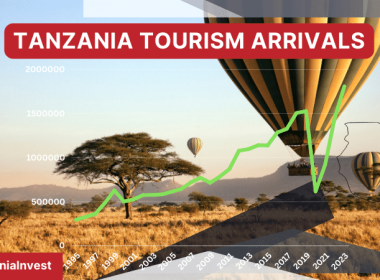
Tanzania Tourist Arrivals Reached Record-Breaking 1.8 Million in 2023
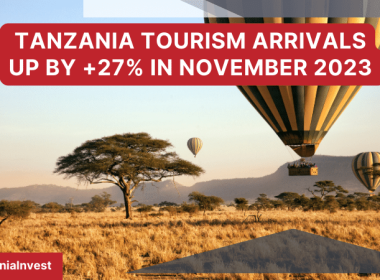
Tanzania Economic Review November 2023: Tourist Arrivals Up by +27%

Tanzania Economic Review October 2023: Export of Traditional Goods Almost Doubled Driven by Coffee and Tobacco

Tanzania Parks Signs Carbon Credit Deal

Tanzania Economic Review, September 2023: Tourism and Transport Receipts Up by 30.5%

Tanzania Economic Review, August 2023: Strong Growth in Coal Exports and Resilient Tourism Sector

Serengeti Voted Africa’s Leading National Park For The 5th Time

Tanzania Coal Exports Triple, Diamond Sales Up By 60%, and Tourism Hits Record High in YE July 2023
Tanzania tourism arrivals surpass 1.6 million in year ending may 2023, reaching historic heights.

Marriott to Open 5-Star Lodge in the Serengeti Park
Privacy overview.
- Where We Work
Tanzania Economic Update: How to Transform Tourism into a More Sustainable, Resilient and Inclusive Sector
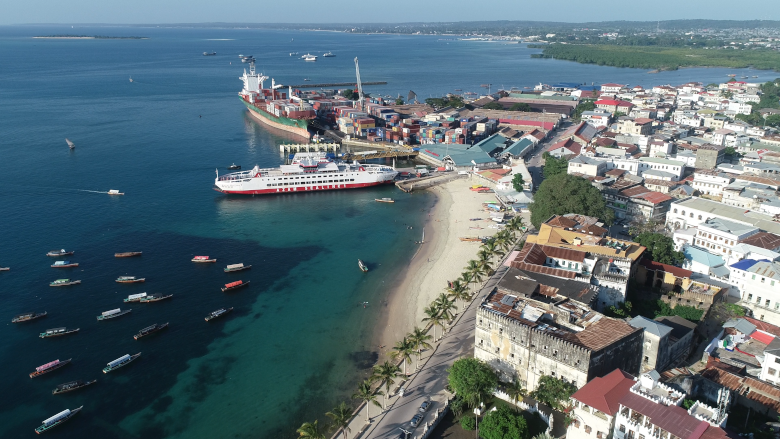
Stone Town, Zanzibar
Photo credit: Christian Morgan/World Bank.
STORY HIGHLIGHTS
- The latest Tanzania Economic Update highlights the huge untapped potential of the tourism sector to drive the country’s development agenda
- The new analysis discusses long-standing issues facing tourism in Tanzania as well as new challenges brought on by the COVID-19 pandemic
- The report says that the pandemic offers an opportunity for policy actions for the sector to recover in the near term and become a sustainable engine of private-sector-driven growth, social and economic inclusion, and climate adaptation and mitigation over the long term
DAR ES SALAAM, July 29, 2021— Tourism offers Tanzania the long-term potential to create good jobs, generate foreign exchange earnings, provide revenue to support the preservation and maintenance of natural and cultural heritage, and expand the tax base to finance development expenditures and poverty-reduction efforts.
The latest World Bank Tanzania Economic Update, Transforming Tourism: Toward a Sustainable, Resilient, and Inclusive Sector highlights tourism as central to the country’s economy, livelihoods and poverty reduction, particularly for women, who make up 72% of all workers in the tourism sector.
“Without tourism, the situation would be bad,” said Rehema Gabriel, a hotel attendant in Dar es Salaam. “I have been working in the tourism industry for eight years now, so I do not know what it would be like without it.”
The economic system around tourism had grown in value over the years and in 2019 was the largest foreign exchange earner, the second largest contributor to the gross domestic product (GDP) and the third largest contributor to employment, the report says. On the semiautonomous Zanzibar archipelago, the sector has also experienced rapid growth, accounting for almost 30% of the island’s GDP and for an estimated 15,000 direct and 50,000 indirect jobs. However, the report notes, only a small fraction of Tanzania’s natural and cultural endowments has been put to economic use through tourism development.
“Tourism offers countries like Tanzania, with abundant natural and cultural endowments, access to many foreign markets,” said Shaun Mann, World Bank Senior Private Sector Development Specialist and co-author of the Tanzania Economic Update. “But the absence of tourism revenues, as we have seen during this pandemic, compromises the integrity and viability of not only endowments, but also the economic, environmental and social ecosystems built up around those endowments.”
Amid the ongoing COVID-19 (coronavirus) pandemic, the World Bank estimates that Tanzania’s GDP growth decelerated to 2.0% in 2020. Business slowed across a wide range of sectors and firms, especially export-oriented sectors such as tourism and manufacturing. The report highlights the impact of the crisis on tourism specifically, which has had consequences beyond just the industry, given the many other sectors that support, and are supported by, tourism. The 72% drop in the sector’s revenues in 2020 (from 2019 levels) closed businesses and caused layoffs.
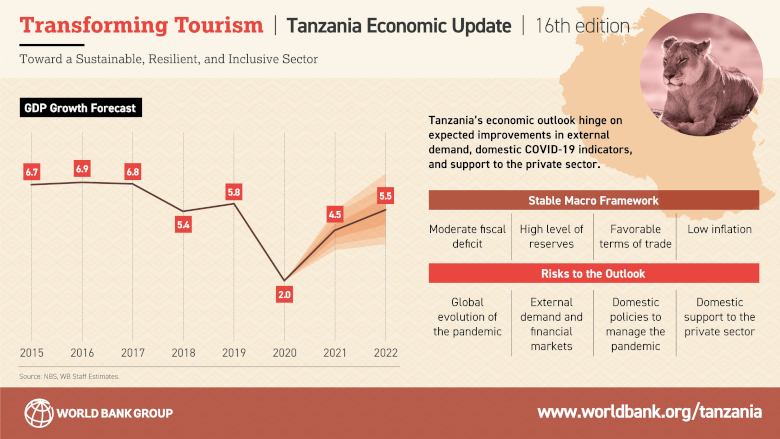
Zanzibar’s economy was even more severely impacted with GDP growth slowing to an estimated 1.3%, driven by a collapse of the tourism industry. As the hospitality industry shut down between March and September 2020, occupancy rates dropped to close to zero. While the Zanzibar tourism sector started slowly rebounding in the last quarter of 2020, with tourist inflows in December 2020 reaching almost 80% of those in 2019, receipts from tourism fell by 38% for the year.
As the tourism sector transitions gradually into recovery mode with the rest of the world, the report urges authorities to look toward its future resilience by addressing long running challenges that could help position Tanzania on a higher and more inclusive growth trajectory. Areas of focus include destination planning and management, product and market diversification, more inclusive local value chains, an improved business and investment climate and new business models for investment that are built on partnership and shared value creation.
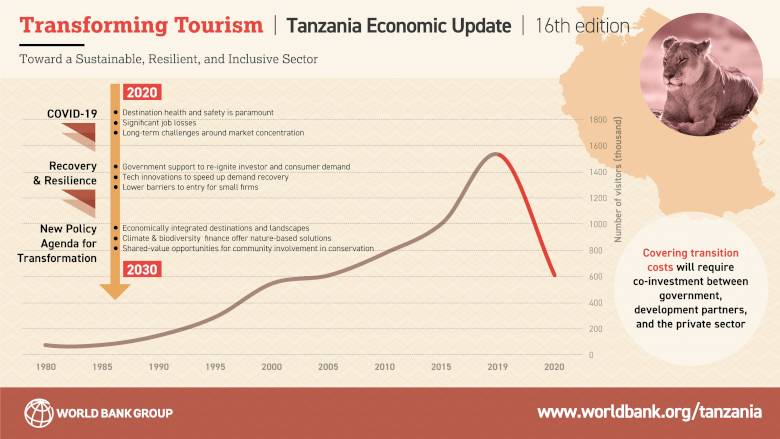
Tanzania is a globally recognized destination for nature-based tourism, a competitive market segment in eastern and southern Africa. Beyond attracting tourists, the country’s landscapes and seascapes produce a wide range of ecosystem services, including carbon sequestration and biodiversity co-benefits that are not efficiently priced and often generate little or no financial return. The global climate crisis has created significant demand for investment in these forms of natural capital, and Tanzania is well positioned to take advantage of nature-positive investment opportunities. The additional revenue derived from global climate programs could be an opportunity to ease the government’s fiscal constraints while also supporting the livelihoods of local communities.
“While restoring the trade and financial flows associated with tourism is an urgent priority, the disruption of the sector has created an opportunity to realign tourism development with economic, social, and environmental resilience,” said Marina Bakanova, World Bank Senior Economist, and co-author of the report. “The pandemic has created an opportunity to implement long-discussed structural reforms in the sector and use tourism as a leading example of improvement of the overall business climate for private investment.”
The authors suggest five priorities for a sustainable and inclusive recovery that lay the foundation for the long-term transformation of the tourism sector:
- Creating an efficient, reliable, and transparent business environment to reduce red tape and multiple distortions and inefficiencies, hindering decisions on private investments, domestic and foreign
- Establishing an information-management system that consolidates data from tourists and firms, enabling policymakers to improve sectoral planning and identify viable investment opportunities
- Ensuring that firms across the sector, as well as those in downstream value chains, have access to affordable transitional finance
- Consistently promoting, monitoring, and reporting on adherence to health and safety protocols.
- Developing co-investment and partnership arrangements to support nature-based landscape and seascape management
- Press Release: Tanzania has an Opportunity to Ignite Inclusive Economic Growth by Transforming its Tourism Sector
- Report: 16th Tanzania Economic Update: ‘Transforming Tourism: Toward a Sustainable, Resilient, and Inclusive Sector’
- Video: Launch event: 16th Tanzania Economic Update
- The World Bank in Tanzania
- The World Bank in Eastern and Southern Africa
- The World Bank in Africa

Tourism in Tanzania
Development of the tourism sector in tanzania from 1995 to 2021.

Revenues from tourism

All data for Tanzania in detail


No spam. We promise.

Tanzania Factsheet
Discover the total economic contribution that the Travel & Tourism sector brings to Tanzania and the world in this data-rich, two-page factsheet.
Discover the direct and total economic contribution that the Travel & Tourism sector brings to the Tanzania’s economies in this comprehensive report.
Discover the direct and total economic contribution that the Travel & Tourism sector brings to Tanzania in this comprehensive report.
Create an account for free or login to download
Over the next few weeks we will be releasing the newest Economic Impact Research factsheets for a wide range of economies and regions. If the factsheet you're interested in is not yet available, sign up to be notified via the form on this page .

Factsheet details
This factsheet highlights the importance of Travel & Tourism to Tanzania across many metrics, and features details such as:
- Contribution of the sector to overall GDP and employment
- Comparisons between 2019 and 2023
- Forecasts for 2024 and 2034
- International and domestic visitor spending
- Proportion of leisure vs business spending
- Top 5 inbound and outbound markets
This latest report reveals the importance of Travel & Tourism to the Tanzania in granular detail across many metrics. The report’s features include:
- Absolute and relative contributions of Travel & Tourism to GDP and employment, international and domestic spending
- Data on leisure and business spending, capital investment, government spending and outbound spending
- Charts comparing data across every year from 2014 to 2024
- Detailed data tables for the years 2018-2023 plus forecasts for 2024 and the decade to 2034
Purchase of this report also provides access to two supporting papers: Methodology and Data Sources and Estimation Techniques.
This latest report reveals the importance of Travel & Tourism to Tanzania in granular detail across many metrics. The report’s features include:
This factsheet highlights the importance of T&T to this city across many metrics, and features details such as:
- Contribution of the sector to overall GDP and employment in the city
- Comparisons between 2019, 2020 and 2021, plus 2022 forecast
- Proportion of the T&T at city level towards overall T&T contribution at a country level
- Top 5 inbound source markets
In collaboration with
Supported by.


Africa energy and utilities - Tax guide 2019

Oil and gas emerging tax issues

National budget 2020/21

Tax and VAT Newsletter
Loading Results
No Match Found
The future of Tourism in Tanzania
Let’s reimagine the future of tourism in tanzania.
Tanzania’s tourism sector is seeing a rebound after the Covid-19 pandemic—and the aspirations for its continued growth are high: by 2025, the country hopes to reach $6 billion in tourism revenue, which assumes the influx of five million tourists annually. To achieve such lofty goals will require some important upgrades and improvements to tourism infrastructure and services. I outline a few of them in this article.
Before the pandemic, tourism was the largest foreign exchange earner, the second largest contributor to the gross domestic product (GDP) and the third largest contributor to employment. After taking a severe hit during Covid, tourists are starting to return to Tanzania, with 742,133 visitors between January and July 2022, a 62.7% increase over the previous year (Exhibit 1).
Exhibit 1: Tourism is returning after the Covid-19 pandemic
But whilst we are doing well, many bottlenecks persist. These include limited access to cheap financing, inadequate tourism infrastructure, a multiplicity of levies, insufficient diversity in products offerings, and lack of sufficient hotel and airport facilities. So how can we measure how we are doing?
Well, the World Economic Forum (“WEF”) in its Travel & Tourism Development Index 2021 (published in May 2022, and themed “Rebuilding for a Sustainable and Resilient Future”) is one barometer of where we stand. It ranks Tanzania as 5 th of the sub-Saharan African (SSA) countries (and 81 st globally out of 117 countries, up from 86 th in 2019). 1 st to 4 th places within SSA are taken by Mauritius (62 nd ), South Africa (68 th ), Botswana (76 th ) and Kenya (78 th ), with 6 th to 10 th places taken by Cape Verde (82 nd ), Namibia (88 th ), Rwanda (89 th ), Zambia (98 th ) and Ghana (101 st ).
According to the WEF report Tanzania and South Africa are very clear leaders within SSA in terms of ranking of natural resources. One aspect to consider further as a significant opportunity is the “non-leisure resources” pillar, which measures the extent and attractiveness of factors that drive business and other non-leisure travel; although Tanzania’s ranking is broadly in line with the SSA average, it does lag Kenya and South Africa by quite a bit. More generally, the WEF report does highlight that East Africa as a region does not rank as highly as Southern Africa in terms of price competitiveness.
Exhibit 2: Tanzania can do more to boost its tourism competitiveness
Tourists coming to Tanzania frequently speak of seeing “the Big Five”. Stakeholders in the tourism sector would also say that they have their “Big Five” namely the “Five A’s”: Attractions, Access, Accommodation, Amenities, and Affordability! From my perspective, and aligned with this, I would highlight some priority areas that need to be addressed by the government and other stakeholders in the tourism sector.
Reduce multiplicity in levies and taxes . There is a need for a fresh look at tourism taxes and levies so as to reduce multiplicity and create competitiveness across the region – indeed, this point was highlighted as an urgent priority in a report recently presented at the 13 th meeting of the Tanzania National Business Council. Currently, Tanzania is deemed an expensive destination compared to other destinations such as South Africa and Kenya. Notwithstanding the positive efforts which led to reduction of some of the levies such as the Tourism Agency License (TALA) fee, there is still scope for rationalization of fees that are charged by multiple government agencies. Further, stakeholders’ engagement prior to fee changes will smoothen the operations of the tourism firms and attract more investments in the sector.
Affordable financing . Tourism firms across the sector, as well as those in downstream value chains, need access to affordable finance particularly in this post Covid-19 era, when the risk appetite for financial institutions in the tourism market is very low. Support from International Development Agencies (IDAs) on the tourism sector should be sought for development projects that have a direct economic impact on the sector and the country as whole.
Improved infrastructure . Tanzania ranks higher than Kenya with respect to safety and security, but lower than Kenya when it comes to tourist service infrastructure. For instance, the drive from Dar es Salaam to Selous Game Reserve, the largest game reserve in Africa is bumpy and long, taking an average of 7 to 8 hours. Flying is a better one option and the fastest way to get to Selous. However, it is the most expensive and hence suits more high-end tourists. Again, IDA support to improve tourist service infrastructure could give a welcome boost.
Upgraded hotels and airport facilities . More effort is required to attract private sector investment in hotels and ensure diversity in service offerings. The current hotel capacity in both Mainland and Zanzibar cannot cater for the expected influx of 5 million tourists by 2025. Improvement in efficiencies and flight handling capacity at the airports is another area which requires fixing. Automation of immigration procedures in Zanzibar and Kilimanjaro Airports will help fast track the process. Instead of having a paperwork checking system, barcodes should be set to scan all the documents. This will help to reduce unnecessary queues at the airports during high season.
Diversified tourism products . Other than wildlife and beaches, the Ministry for Tourism should spearhead the innovation of new tourist attractions. The recent decision to market Ngorongoro-Lengai geo park and the introduction of “Mice” (meetings, incentives, conferences, and exhibitions) are commendable efforts as these will boost tourism income, since Tanzania is an already established adventure destination.
Introduction of direct flights and collaborations with aviation industry . The signing of a memorandum of understanding between the Tanzanian Government and Dallas in April 2022 was one of the great achievements of the Royal Tour of the United States by her Excellency Samia Suluhu Hassan, as this will attract more American visitors to Tanzania's tourist destinations. More direct flights need to be added to key markets while maintaining a closer collaboration between the aviation and tourism industries for sustainable growth of the sector. This will ease flight interconnectivity to tourists who prefer to do inter-connected travels.
Raising public awareness . More education is needed for the public and journalists to help promote the tourism sector. Although we are in the era of freedom of speech, care should be taken not to exaggerate unproven facts that are detrimental to the sector’s growth.
In conclusion, the target of $6 billion by 2025 is achievable—but it will require deliberate efforts to make it a reality. The President’s Royal Tour is expected to bring a significant boost to the numbers in 2022 and beyond. The tourism sector needs to be given the utmost priority due to its huge potential in transforming the country’s economy as the sector contributes significantly to foreign exchange and employment.
By Zainab Salome Msimbe is a Partner with PwC Tanzania

Pauline Koola
Manager, PwC Tanzania
Tel: +255 (0) 22 219 2000

© 2010 - 2024 PwC. All rights reserved. PwC refers to the PwC network and/or one or more of its member firms, each of which is a separate legal entity. Please see www.pwc.com/structure for further details.
- About Site Provider
- Cookie information

International tourism, receipts (current US$) - Tanzania

Selected Countries and Economies
All countries and economies.
- Privacy Notice
- Access to Information
This site uses cookies to optimize functionality and give you the best possible experience. If you continue to navigate this website beyond this page, cookies will be placed on your browser. To learn more about cookies, click here.
Travel & Tourism - Tanzania
- The Travel & Tourism market in Tanzania is expected to see a significant rise in revenue, with projections indicating a revenue of US$840.30m in 2024.
- The market is expected to maintain a steady annual growth rate (CAGR 2024-2028) of 5.32%, which will result in a projected market volume of US$1,034.00m by 2028.
- The Hotels market is predicted to be the largest market, with a projected market volume of US$413.10m in 2024.
- By 2028, the number of users in this market is expected to reach 6,676.00k users.
- The user penetration in the Hotels market is expected to rise from 12.4% in 2024 to 13.5% by 2028.
- Additionally, the average revenue per user (ARPU) is projected to be US$97.71.
- In terms of online sales, it is expected that 69% of the total revenue will be generated through online sales by 2028.
- It is worth noting that when compared globally, United States is predicted to generate the most revenue in the Travel & Tourism market, with a projected revenue of US$199bn in 2024.
- Tanzania's Travel & Tourism market is experiencing a rise in ecotourism, with visitors flocking to explore the country's diverse wildlife and natural landscapes.
Key regions: Malaysia , Europe , Singapore , Vietnam , United States
Definition:
The Travel & Tourism market encompasses a diverse range of accommodation services catering to the needs and preferences of travelers. This dynamic market includes package holidays, hotel accommodations, private vacation rentals, camping experiences, and cruises.
The market consists of five further markets.
- The Cruises market covers multi-day vacation trips on a cruise ship. The Cruises market encompasses exclusively passenger ticket revenues.
- The Vacation Rentals market comprises of private accommodation bookings which includes private holiday homes and houses as well as short-term rental of private rooms or flats.
- The Hotels market includes stays in hotels and professionally run guest houses.
- The Package Holidays market comprises of travel deals that normally contain travel and accommodation sold for one price, although optional further provisions can be included such as catering and tourist services.
- The Camping market includes bookings at camping sites for pitches using tents, campervans, or trailers. These can be associated with big chains or privately managed campsites.
Additional Information:
The main performance indicators of the Travel & Tourism market are revenues, average revenue per user (ARPU), users and user penetration rates. Additionally, online and offline sales channel shares display the distribution of online and offline bookings. The ARPU refers to the average revenue one user generates per year while the revenue represents the total booking volume. Revenues are generated through both online and offline sales channels and include exclusively B2C revenues and users for the above-mentioned markets. Users represent the aggregated number of guests. Each user is only counted once per year. Additional definitions for each market can be found within the respective market pages.
The booking volume includes all booked travels made by users from the selected region, independent of the departure and arrival. The scope includes domestic and outbound travel.
Prominent players in this sector include online travel agencies (OTAs) like Expedia and Opodo, as well as tour operators such as TUI. Specialized platforms like Hotels.com, Booking.com, and Airbnb facilitate the online booking of hotels and private accommodations, contributing significantly to the market's vibrancy.
For further information on the data displayed, refer to the info button right next to each box.
- Bookings directly via the website of the service provider, travel agencies, online travel agencies (OTAs) or telephone
out-of-scope
- Business trips
- Other forms of trips (e.g. excursions, etc.)
Travel & Tourism
- Vacation Rentals
- Package Holidays
- Analyst Opinion
The Travel & Tourism market in Tanzania is experiencing significant growth and development. Customer preferences: Tourists visiting Tanzania are increasingly seeking unique and authentic experiences, driving the demand for eco-tourism and cultural tourism. Travelers are drawn to Tanzania's diverse wildlife, stunning landscapes, and rich cultural heritage, leading to a rise in experiential travel activities such as safari tours, mountain climbing, and cultural immersions. Trends in the market: One notable trend in the Tanzanian travel market is the growing popularity of sustainable tourism practices. With an increased global focus on environmental conservation and responsible travel, Tanzania has seen a rise in eco-friendly lodges, wildlife conservation projects, and community-based tourism initiatives. Additionally, the country's efforts to improve infrastructure and promote tourism outside of traditional hotspots like Zanzibar and Serengeti have contributed to a more diversified tourism landscape. Local special circumstances: Tanzania's unique selling points, such as being home to the majestic Mount Kilimanjaro, the Serengeti National Park, and the idyllic islands of Zanzibar, set it apart as a prime tourist destination in East Africa. The country's rich cultural tapestry, including over 120 ethnic groups, offers visitors a chance to engage with diverse traditions and customs. Moreover, Tanzania's stable political environment and commitment to wildlife conservation make it an attractive and safe destination for travelers. Underlying macroeconomic factors: The Tanzanian government's focus on promoting the travel and tourism sector as a key driver of economic growth has led to investments in infrastructure development, marketing campaigns, and policy reforms to attract more tourists. The country's strategic location in East Africa, with easy access to regional markets and international air travel hubs, further enhances its position as a competitive tourism destination. Additionally, the growth of the middle class in emerging markets has increased disposable income and fueled outbound travel to destinations like Tanzania.
- Methodology
Data coverage:
Modeling approach:
Additional notes:
- Sales Channels
- Travel Behavior
- Global Comparison
- Key Market Indicators
Mon - Fri, 9am - 6pm (EST)
Mon - Fri, 9am - 5pm (SGT)
Mon - Fri, 10:00am - 6:00pm (JST)
Mon - Fri, 9:30am - 5pm (GMT)
- Unlimited access to our Market Insights
- Statistics and reports
- Usage and publication rights
This website stores cookies on your computer. These cookies are used to collect information about how you interact with our website and allow us to remember you. We use this information in order to improve and customize your browsing experience and for analytics and metrics about our visitors both on this website and other media. To find out more about the cookies we use, see our Cookies Policy .
If you decline, your information won’t be tracked when you visit this website. A single cookie will be used in your browser to remember your preference not to be tracked.
Tanzania Tourism Statistics
Tanzania tz: international tourism: expenditures, view tanzania's tanzania tz: international tourism: expenditures from 1995 to 2016 in the chart:.
Tanzania TZ: International Tourism: Expenditures: % of Total Imports
View tanzania's tanzania tz: international tourism: expenditures: % of total imports from 1995 to 2016 in the chart:.
Tanzania TZ: International Tourism: Expenditures: for Passenger Transport Items
View tanzania's tanzania tz: international tourism: expenditures: for passenger transport items from 1997 to 2016 in the chart:.
Tanzania TZ: International Tourism: Expenditures: for Travel Items
View tanzania's tanzania tz: international tourism: expenditures: for travel items from 1995 to 2016 in the chart:.
Tanzania TZ: International Tourism: Number of Arrivals
View tanzania's tanzania tz: international tourism: number of arrivals from 1995 to 2016 in the chart:.
Tanzania TZ: International Tourism: Receipts
View tanzania's tanzania tz: international tourism: receipts from 1995 to 2016 in the chart:.
Tanzania TZ: International Tourism: Receipts: % of Total Exports
View tanzania's tanzania tz: international tourism: receipts: % of total exports from 1995 to 2016 in the chart:.
Tanzania TZ: International Tourism: Receipts: for Passenger Transport Items
View tanzania's tanzania tz: international tourism: receipts: for passenger transport items from 1997 to 2016 in the chart:.
Tanzania TZ: International Tourism: Receipts: for Travel Items
View tanzania's tanzania tz: international tourism: receipts: for travel items from 1995 to 2016 in the chart:.
Explore our Data

Macroeconomic Indicators
- Gross Domestic Product (GDP)
- Consumer Price Index (CPI)
- Producer Price Index (PPI)
- Index of Industrial Production (IIP)
- Trade Price Indices (TPI)
- High Frequency Data
- Tax Statistics
- Hotel Statistics
- Tourism Statistics
- Investment Statistics
- Employment Statistics
Quick Statistics
- Tanzania in Figures
- Tanzania Statistical Abstract
- 2012 PHC: Regional Profiles
- Poverty Assessment
- Other Statistics
- Women and Men Facts and Figures
Social Media
News and Events
- News Letter
Social Statistics Indicators
- Education Statistics
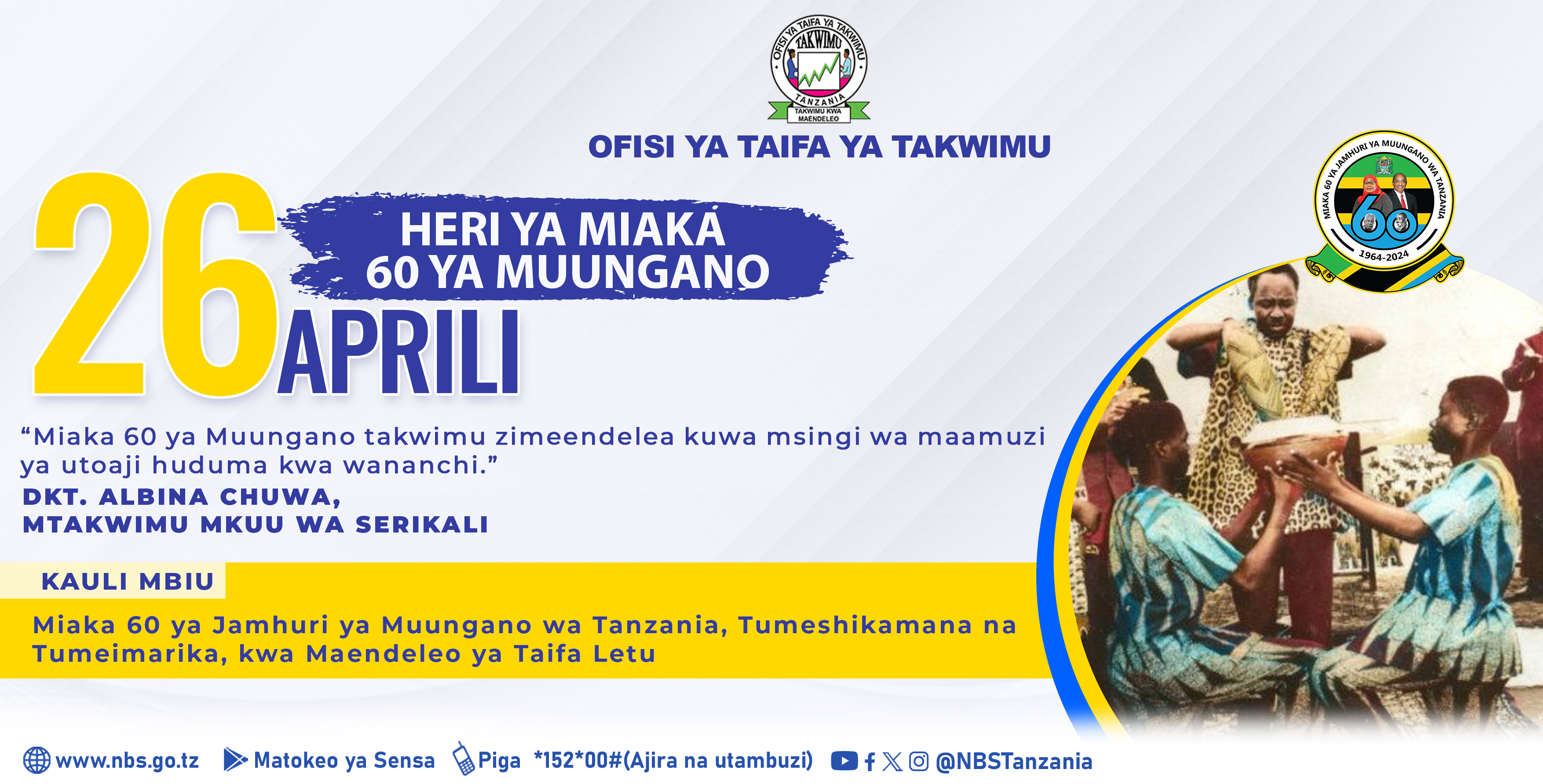
Latest News
Hali ya Uchumi wa Taifa katika mwaka 2022
Insights that Drive Innovation - FinScope Tanzania 2023
SDGs Indicators in Brief June 2023
Taarifa ya Idadi ya Watu Kabla, Wakati na Baada ya Muungano
Demographic and Health Survey (DHS) 2022 - Key Indicators Report
Social Institutions and Gender Index (SIGI) - Tanzania Reports
COVID-19 response - Resources for Official Statisticians
- You are here:

IMAGES
VIDEO
COMMENTS
Tourist Arrivals for the Period of January to February, 2023. Press Release Tourist Arrivals January to December, 2022. Tanzania Tourism Sector Survey Report 2019. Tanzania Tourism Sector Survey Report 2018. Tourist Arrivals for the Period of January to July 2022. Tourist Arrivals for the period of January to May 2022.
Tanzania tourism statistics for 2021 was 0.00, a NAN% decline from 2020. Tanzania tourism statistics for 2020 was 0.00, a 100% decline from 2019. Tanzania tourism statistics for 2019 was 2,624,500,000.00, a 6.47% increase from 2018. Download Historical Data.
In 2023, tourist arrivals to Tanzania increased by 24.3% to a record-breaking 1,808,205, from 1,454,920 tourists in 2022, 922,692 in 2021, and 616,491 in 2020. Tanzania's tourism receipts reached a record-high USD 3,368.7 million in 2023, compared to USD 2,527.8 million in 2022 (USD 1,310.3 million in 2021). This increase is consistent with ...
International tourism, number of arrivals - Tanzania World Tourism Organization, Yearbook of Tourism Statistics, Compendium of Tourism Statistics and data files. License : CC BY-4.0
Tanzania in Figures 2020 booklet gives clear insight of Tanzania's economic performance, social, environment and political spheres. This booklet presents data series for the period from 2016 to 2020. Further, the booklet provides aggregated data and contains information from various official statistical publications compiled by the National ...
Tanzania is a globally recognized destination for nature-based tourism, a competitive market segment in eastern and southern Africa. Beyond attracting tourists, the country's landscapes and seascapes produce a wide range of ecosystem services, including carbon sequestration and biodiversity co-benefits that are not efficiently priced and often generate little or no financial return.
MONTHLY TOURIST ARRIVALS BY …. Find comprehensive library of public information on Tourism with relevant datasets, predefined dashboards and the gallery of ready-to-use visualizations. With world maps, rankings, and interactive tables with statistics on Tourism.
Tourist arrivals in Tanzania 2015-2022. Published by. Natalie Cowling , Jan 30, 2024. Roughly 368,000 tourists visited Tanzania from January to April 2022. The tourism sector has shown signs of ...
In 2019, the Tanzanian tourism sector generated US$2.6 billion in revenues with 1.5 million tourist arrivals [7] . In 2020, due to Covid-19, travel receipts declined to US$1.06 billion and the number of international tourist arrivals declined to 616,491. In October 2021, the Ministry of Natural Resources and Tourism of Tanzania has been granted ...
Tourism in Tanzania Tanzania recorded a total of 922,700.00 tourists in 2021, ranking 49th in the world in absolute terms. ... Our data on tourist numbers, revenues and expenditures are based on information from the World Tourism Organization. However, to ensure international comparability, the data for some years or countries were manually ...
Number of visitors to national parks in Tanzania 2015-2019, by type. Average expense at selected beach destinations in Tanzania, by cost factor 2018. Main nationalities of tourists arriving in ...
spheres. Tanzania in Figures 2019 booklet presents the data series for the period from 2015 to 2019. This booklet provides aggregated data and contains information from various official statistical publications compiled by the National Bureau of Statistics (NBS), sector ministries, Government Departments and Agencies. The indicators presented are
Directly accessible data for 170 industries from 150+ countries and over 1 Mio. facts. ... Monthly number of tourist arrivals in Tanzania from January 2019 to February 2022 (in 1,000s) [Graph ...
Factsheet details. This factsheet highlights the importance of Travel & Tourism to Tanzania across many metrics, and features details such as: Contribution of the sector to overall GDP and employment. Comparisons between 2019 and 2023. Forecasts for 2024 and 2034. International and domestic visitor spending. Proportion of leisure vs business ...
Tanzania National Data Archive (TNADA) Africa Information Highway; Southern African Development Community; Tanzania Goal Tracker -SDG data; ... Tanzania Tourism Sector Survey Report 2019 On development, tourism continues to be an important source of Tanzania's foreign earnings. In 2019, earnings from tourism increased by 7.9 percent to USD ...
Let's reimagine the future of Tourism in Tanzania. Tanzania's tourism sector is seeing a rebound after the Covid-19 pandemic—and the aspirations for its continued growth are high: by 2025, the country hopes to reach $6 billion in tourism revenue, which assumes the influx of five million tourists annually. To achieve such lofty goals will ...
Tanzania National Data Archive (TNADA) 2022 Census Information ; Tanzania Socio-Economic Database (TSED) Food and Agriculture Statistics (CountrySTAT) ... Tanzania Tourism Sector Survey Report 2019 On development, tourism continues to be an important source of Tanzania's foreign earnings. In 2019, earnings from tourism increased by 7.9 ...
TOURISM STATISTICS Zanzibar recorded 66,720 international visitors in December 2022 which is an increase of 38.5 percent compared with 48,167 visitors recorded in December 2021 and increased by 21.0 percent compared with 55,150 visitors recorded in the preceding month (November 2022). Tourists from Europe continued to dominate the market by accounting (68.1 percent) of the
International tourism, receipts (current US$) - Tanzania World Tourism Organization, Yearbook of Tourism Statistics, Compendium of Tourism Statistics and data files. License : CC BY-4.0
The Travel & Tourism market in in Tanzania is projected to grow by 5.32% (2024-2028) resulting in a market volume of US$1,034.00m in 2028. ... Directly accessible data for 170 industries from 150 ...
The data reached an all-time high of 2.157 USD bn in 2016 and a record low of 343.000 USD mn in 1997. TZ: International Tourism: Receipts data remains active status in CEIC and is reported by World Bank. The data is categorized under Global Database's Tanzania - Table TZ.World Bank: Tourism Statistics.
Reports show that Tanzania tourism depends much on wildlife attractions as 36.4% of tourists who visit Tanzania, prefer to visit wildlife attractions (Tanzania Tourism Sectoral Survey Report, Citation 2019). This is due to the availability of varieties of wildlife areas ranging from national parks, game reserves, game-controlled areas, and ...
Tanzania in Figures 2021 booklet gives clear insight of Tanzania's economic performance, social, environment and political spheres. This booklet presents data series for the period from 2016 to 2021. Further, the booklet provides aggregated data and contains information from various official statistical publications compiled by the National ...
TASIS - Tanzania Statistical Information Service. Tanzania Socio-Economic Database (TSED) Tanzania National Data Archive (TNADA) Africa Information Highway. Southern African Development Community. Tanzania Goal Tracker -SDG data. Agriculture 2019/20 - Table Retrieval System. 2022 Census Information. Publications.